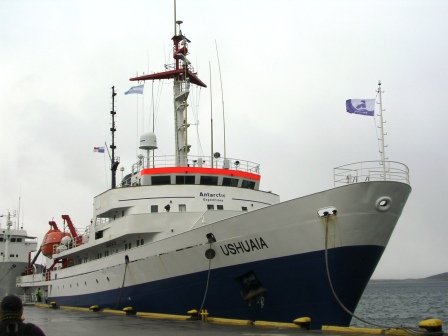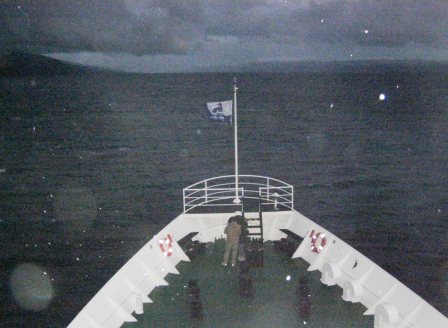Exploring Antarctica
Venturing Beyond the Familiar

M/V Ushuaia
The winter months in the Northern Hemisphere offer the ideal window to visit Antarctica, as it's their summer season. Departing from San Francisco, your journey will most likely begin with a flight to Buenos Aires, Argentina. This vibrant city is a destination in itself and well worth exploring either before or after your Antarctic adventure. Your next leg will be a roughly 4-hour jet flight to Ushuaia, a small tourist outpost nestled at the southernmost tip of South America. While Buenos Aires enjoys an average summer temperature of around 80 degrees Fahrenheit, Ushuaia's average summer temperature hovers around 40 degrees Fahrenheit. However, as you venture further south to the Antarctic Peninsula during its summer, you can expect temperatures of 20 degrees Fahrenheit or even lower. You'll notice a significant drop in temperature the more southward you travel.

Snowing on the Beagle Channel
My arrival in Ushuaia in November 2007 coincided with a significant snowstorm. Snow and sleet whipped sideways across the runway at over 30 mph. Fortunately, a sky bridge provided a sheltered exit from the airplane, shielding me from the freezing conditions outside. After collecting my luggage, I boarded a small bus that shuttled us through Ushuaia to the docks. There, my ship, the M/V Ushuaia, awaited. A brief walk from the bus to the ship exposed me to the full force of the bitter cold. After a few quick photos, I boarded, registered, and was shown to my cabin. The room was compact but adequate for myself and my brother, with whom I was sharing. We also shared a bathroom with another cabin, but we quickly connected with our neighbors and established a comfortable arrangement.
Antarctica, the forgotten continent (Part One)
Following a brief reception and orientation lecture, a mandatory lifeboat drill was conducted. Afterward, we enjoyed dinner, and the ship set sail through the scenic Beagle Channel, heading towards the open ocean and the notorious Drake Passage. The Beagle Channel is named after the HMS Beagle, the ship on which Charles Darwin embarked on his groundbreaking voyage. The HMS Beagle navigated this channel on its way to the Pacific Ocean on January 29, 1833.
Despite predictions of 30 mph winds in the Drake Passage, our departure was only slightly delayed, not canceled. The passage through the Beagle Channel was smooth and tranquil. However, the anticipated high winds in the Drake Passage had everyone discussing their motion sickness remedies and coping strategies. I had already applied my behind-the-ear patch as a preemptive measure against this dreaded ailment. Unfortunately, no medication or technique can entirely prevent the discomfort induced by sailing the Drake Passage; it's something one must simply endure.
Antarctica, the forgotten continent (Part Two)
The crossing of the infamous Drake Passage from Ushuaia to the Antarctic Peninsula typically takes around 2.5 days. Its infamy stems from its well-deserved reputation for extremely rough seas. Another factor that makes travel here challenging, particularly in November, is that the sun doesn't set until after midnight. Adding to the intensity of this particular trip was the Antarctic summer of 2007, which locals referred to as a Shackleton Summer. This term alludes to the exceptionally cold summer weather encountered by the great Antarctic explorer, Sir Ernest Henry Shackleton, during his ill-fated expedition of 1914-17. Disaster struck when his ship, the HMS Endurance, became trapped and was eventually crushed by pack ice, leaving the expedition stranded in the harsh Antarctic environment.
The adventure continues in my next article.
Exploring Antarctica: Navigating the Drake Passage.
More information:
Betchart Expeditions
Buenos Aires
Ushuaia
M/V Ushuaia
Beagle Channel
Drake Passage
Sir Ernest Henry Shackleton